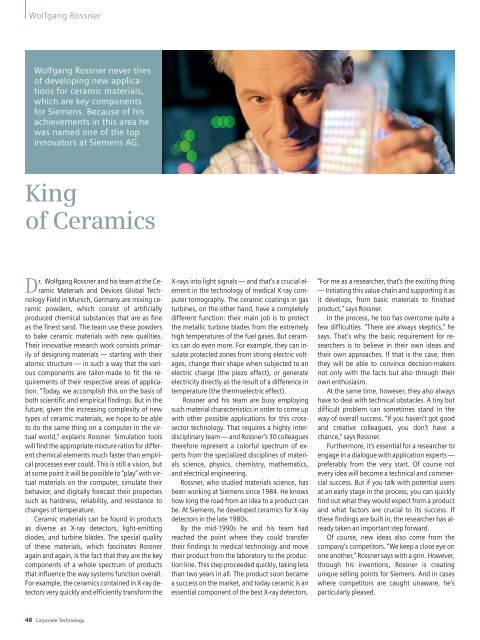Corporate Technology - Rolf Hellinger
Corporate Technology - Rolf Hellinger
Corporate Technology - Rolf Hellinger
You also want an ePaper? Increase the reach of your titles
YUMPU automatically turns print PDFs into web optimized ePapers that Google loves.
Wolfgang Rossner<br />
Wolfgang Rossner never tires<br />
of developing new applications<br />
for ceramic materials,<br />
which are key components<br />
for Siemens. Because of his<br />
achievements in this area he<br />
was named one of the top<br />
innovators at Siemens AG.<br />
King<br />
of Ceramics<br />
Dr. Wolfgang Rossner and his team at the Ceramic<br />
Materials and Devices Global <strong>Technology</strong><br />
Field in Munich, Germany are mixing ceramic<br />
powders, which consist of artificially<br />
produced chemical substances that are as fine<br />
as the finest sand. The team use these powders<br />
to bake ceramic materials with new qualities.<br />
Their innovative research work consists primarily<br />
of designing materials — starting with their<br />
atomic structure — in such a way that the various<br />
components are tailor-made to fit the requirements<br />
of their respective areas of application.<br />
“Today, we accomplish this on the basis of<br />
both scientific and empirical findings. But in the<br />
future, given the increasing complexity of new<br />
types of ceramic materials, we hope to be able<br />
to do the same thing on a computer in the virtual<br />
world,” explains Rossner. Simulation tools<br />
will find the appropriate mixture ratios for different<br />
chemical elements much faster than empirical<br />
processes ever could. This is still a vision, but<br />
at some point it will be possible to “play” with virtual<br />
materials on the computer, simulate their<br />
behavior, and digitally forecast their properties<br />
such as hardness, reliability, and resistance to<br />
changes of temperature.<br />
Ceramic materials can be found in products<br />
as diverse as X-ray detectors, light-emitting<br />
diodes, and turbine blades. The special quality<br />
of these materials, which fascinates Rossner<br />
again and again, is the fact that they are the key<br />
components of a whole spectrum of products<br />
that influence the way systems function overall.<br />
For example, the ceramics contained in X-ray detectors<br />
very quickly and efficiently transform the<br />
48 <strong>Corporate</strong> <strong>Technology</strong><br />
X-rays into light signals — and that’s a crucial element<br />
in the technology of medical X-ray computer<br />
tomography. The ceramic coatings in gas<br />
turbines, on the other hand, have a completely<br />
different function: their main job is to protect<br />
the metallic turbine blades from the extremely<br />
high temperatures of the fuel gases. But ceramics<br />
can do even more. For example, they can insulate<br />
protected zones from strong electric voltages,<br />
change their shape when subjected to an<br />
electric charge (the piezo effect), or generate<br />
electricity directly as the result of a difference in<br />
temperature (the thermoelectric effect).<br />
Rossner and his team are busy employing<br />
such material characteristics in order to come up<br />
with other possible applications for this crosssector<br />
technology. That requires a highly interdisciplinary<br />
team — and Rossner’s 30 colleagues<br />
therefore represent a colorful spectrum of experts<br />
from the specialized disciplines of materials<br />
science, physics, chemistry, mathematics,<br />
and electrical engineering.<br />
Rossner, who studied materials science, has<br />
been working at Siemens since 1984. He knows<br />
how long the road from an idea to a product can<br />
be. At Siemens, he developed ceramics for X-ray<br />
detectors in the late 1980s.<br />
By the mid-1990s he and his team had<br />
reached the point where they could transfer<br />
their findings to medical technology and move<br />
their product from the laboratory to the production<br />
line. This step proceeded quickly, taking less<br />
than two years in all. The product soon became<br />
a success on the market, and today ceramic is an<br />
essential component of the best X-ray detectors.<br />
“For me as a researcher, that’s the exciting thing<br />
— Initiating this value chain and supporting it as<br />
it develops, from basic materials to finished<br />
product,” says Rossner.<br />
In the process, he too has overcome quite a<br />
few difficulties. “There are always skeptics,” he<br />
says. That’s why the basic requirement for researchers<br />
is to believe in their own ideas and<br />
their own approaches. If that is the case, then<br />
they will be able to convince decision-makers<br />
not only with the facts but also through their<br />
own enthusiasm.<br />
At the same time, however, they also always<br />
have to deal with technical obstacles. A tiny but<br />
difficult problem can sometimes stand in the<br />
way of overall success. “If you haven’t got good<br />
and creative colleagues, you don’t have a<br />
chance,” says Rossner.<br />
Furthermore, it’s essential for a researcher to<br />
engage in a dialogue with application experts —<br />
preferably from the very start. Of course not<br />
every idea will become a technical and commercial<br />
success. But if you talk with potential users<br />
at an early stage in the process, you can quickly<br />
find out what they would expect from a product<br />
and what factors are crucial to its success. If<br />
these findings are built in, the researcher has already<br />
taken an important step forward.<br />
Of course, new ideas also come from the<br />
company’s competitors. “We keep a close eye on<br />
one another,” Rossner says with a grin. However,<br />
through his inventions, Rossner is creating<br />
unique selling points for Siemens. And in cases<br />
where competitors are caught unaware, he’s<br />
particularly pleased.


